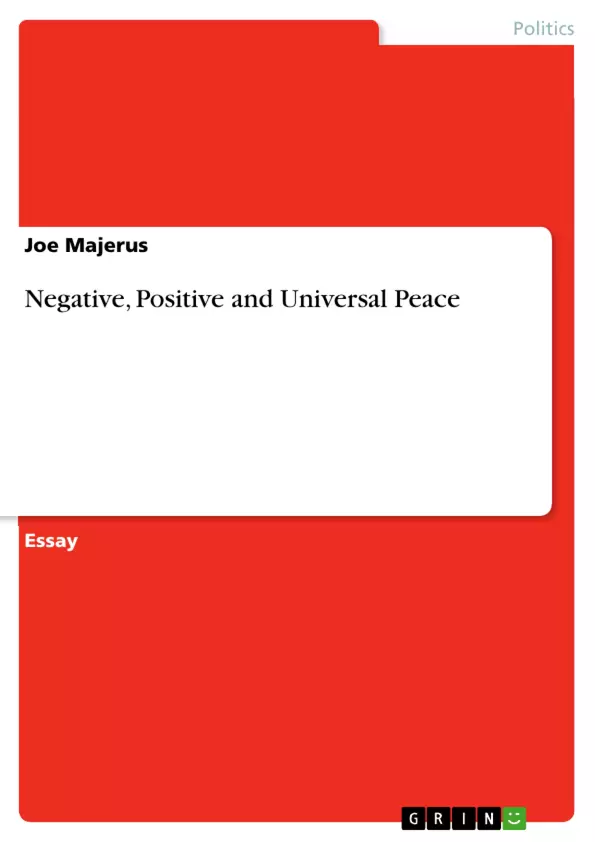What is the essence of international peace and how can it be achieved? Innumerable attempts have been made in the past to seek out the answer to that pivotal question. Countless efforts have gone into supranational endeavours designed to promote a less conflict-ridden international order. Over the centuries historians, IR theorists, strategists, peace researchers, economists and public servants have developed many explanatory models and practical measures which, so it was hoped, would offer world society a more effective approach to the age-old problem of finding an applicable solution to the creation and preservation of international peace.
Yet the word "peace" is evidently an ambiguous and multi-faceted concept with very distinctive meanings and connotations to individual peoples in different countries and at different times throughout history—and thus with likewise very unique ideas and perspectives on how to realize it. In view of this, the academic field of Peace and Conflict studies generally distinguishes between 'negative' and 'positive' peace.
Table of Contents
- Negative, Positive and Universal Peace
- The Dualistic Nature of Peace
- Negative Peace without Justice
- The Case of the “Long Peace”
- Positive and Negative Peace in Concert
- Universal Peace
Objectives and Key Themes
This text examines the multifaceted concept of peace, exploring its different forms and the factors that contribute to its realization and maintenance. It aims to provide a comprehensive understanding of the dynamics of international peace, highlighting the importance of both negative and positive peace elements.
- Defining and differentiating between negative and positive peace
- Analyzing the relationship between negative peace, justice, and tension
- Examining the role of power dynamics and security fears in international peace
- Exploring the concept of universal peace and its significance
- Highlighting the interdependence and reciprocal nature of negative and positive peace
Chapter Summaries
- Negative, Positive and Universal Peace: Introduces the central theme of the text – peace – and discusses its diverse interpretations and meanings, particularly differentiating between "negative" and "positive" peace. It examines the historical context of peace research and explores the different scenarios where various forms of peace manifest.
- The Dualistic Nature of Peace: Delves deeper into the concept of negative peace, contrasting it with positive peace. This section outlines the key characteristics of each type of peace, including the absence of violence, presence of justice, and the role of societal equality. It examines the complexities of peace agreements and their potential limitations, particularly regarding justice and the persistence of negative peace without significant advancements in positive peace.
- Negative Peace without Justice: Explores instances where negative peace exists without a concurrent presence of justice. The text uses the Cold War as a significant example, highlighting the inherent instability of this form of peace due to underlying tensions and the perpetual threat of conflict. The section also discusses the fragile nature of negative peace and the risks of its breakdown due to unresolved grievances and the lack of structural harmony.
- The Case of the “Long Peace”: Examines the "Long Peace" phenomenon, characterized by a prolonged period of relative stability despite ongoing tensions and the potential for conflict. The text analyzes the underlying factors that contributed to this period, including the balance of power and nuclear deterrence, while acknowledging the inherent risks and vulnerabilities associated with this type of peace.
- Positive and Negative Peace in Concert: Emphasizes the interrelationship between negative and positive peace, highlighting their interdependence and reciprocal nature. The text argues that a genuine and lasting peace necessitates a combination of both elements, where efforts to foster justice and equality can contribute to the strengthening and sustainability of negative peace. It also explores the concept of peace-building and the importance of addressing systemic imbalances and inequalities for a more resilient and sustainable international order.
Keywords
Key terms and topics explored in this text include: negative peace, positive peace, universal peace, international peace, justice, equality, tension, violence, power dynamics, security, peace-building, global order, structural violence, human rights, conflict resolution, and peace studies.
- Quote paper
- Joe Majerus (Author), 2017, Negative, Positive and Universal Peace, Munich, GRIN Verlag, https://www.grin.com/document/432933



